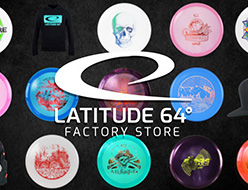Sinus – the history and future of one of the first L64 discs
Tomas Ekström, founder and disc designer of Latitude 64°, reflects on the legacy and evolution of one of the company’s earliest and most iconic discs, the Sinus, which first launched in 2006. Known for its dependability and unique thumb pads, the Sinus gained a strong following among disc golfers. Now, Latitude 64° has introduced an upgraded version of the Sinus with a new mold, going back to the overstable flights from 2006, and also a way smoother grip.
“When we tested Sinus for the first time, it was a cold winter day in March, and as most people know, discs fly a little more understable in cold air,” Ekström recalls. “That day, it flew stable and straight with good torque resistance, which was something we appreciated. But later, as temperatures warmed up, especially the Soft version, we realized it was actually quite overstable for putting. That was maybe a small mistake, but the disc still flew well, and it found a place with many fans.”
This initial release of the Sinus was known for its two plastic variations—the AP (Approach) and the SP (Soft Putter) — as well as its distinct thumb pads. While the thumb pads were a novelty, they came with some challenges. “The thumb pads were a bit of an experiment and a little gimmick to get people to notice a new disc company from Sweden. The idea was that the rough texture would improve grip, but ironically, it didn’t work that well when the disc was dry. It worked better in the rain, though!” Ekström adds with a smile.

Tomas Ekström.
Despite these quirks, the Sinus stayed relevant for nearly two decades due to its unique characteristics. “The plastic played a big role. Our Zero Line plastic, which we made from the beginning, has a nice dry feel and excellent grip, perfect for putters and approach discs. The Sinus also stood out because it was one of the first truly overstable putters on the market. Even after all these years, it’s still a reliable and stable throwing putter that almost never wants to flip. That dependability is what makes it so great.”
Ekström also shares his personal connection to the disc. “I putted with Sinus for an entire season when we first made it, and despite its overstability and significant fade, I had one of my best putting seasons ever. It was strange, but I putted better than ever with it. The AP version also became my go-to for short holes and approaches—it’s a disc that just keeps getting better the more you play with it.”
Now, with the release of the new Sinus mold, Latitude 64° has refined the original design, focusing on delivering a smoother grip without the thumb pads and enhancing the disc’s stability. “It feels and looks like the original Sinus, but the grip is much nicer due to less flashing. It’s an exciting evolution of a classic disc, says Tomas.
The new Sinus will hit the disc golf shelves in September 26th.





